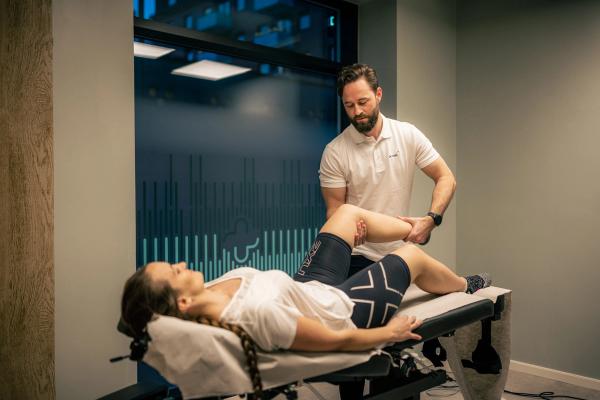Shin splints
Shin splints are a condition that leads to pain along the inside (medial tibial stress syndrome) or front of the shin. It often develops due to overuse, particularly in activities like running or prolonged walking. Contributing factors may include inadequate footwear and excess weight. Pain can be most intense in the morning or after extended periods of inactivity, such as getting out of bed or sitting for a long time.
At Dr. Dropin, we have skilled practitioners who can assess your elbow pain and help you receive the appropriate treatment.
See availability
What are you looking for?
Symptoms of shins splints
The following symptoms may indicate that you have developed golfer's elbow:
- Pain on the inside of the elbow or forearm
- Pain when gripping objects, lifting, pulling, or pushing
- Stiffness and pain when you start using your arm, and sometimes after the activity
- Tenderness around the bony bump on the inside of the elbow
Golfer's elbow is a condition that can develop gradually, and the symptoms can vary in intensity. It is important to seek professional guidance for an accurate diagnosis and treatment if you experience these symptoms.
See availability
Treatment
The treatment of shin splints often involves various approaches to achieve different treatment goals. Here are some common focus areas in the treatment:
- Pain Relief: Reduce heel pain through manual techniques such as joint adjustments, massage, and trigger point therapy.
- Shockwave Therapy: Stimulate faster recovery.
- Increased Flexibility: Specific stretching exercises and techniques to improve mobility in the shin and foot.
- Strength Training: Gradual introduction of strength exercises for the muscles in the shin and foot to reduce strain on the tendon.
- Biomechanical Evaluation: Analysis of running technique and customization of footwear or insoles to decrease stress on the shin.
- Functional Rehabilitation: Gradual resumption of running and daily activities, focusing on restoring optimal foot function.
Treatment needs to be tailored to individual needs and may vary. A thorough evaluation and collaboration with an experienced physiotherapist or chiropractor are crucial to develop an effective treatment plan.
When should you book an appointment?
If you recognize the symptoms above and are experiencing any of the following issues, we recommend seeking professional guidance:
- Pain or reduced mobility that has persisted for more than a week without improvement.
- Severe symptoms that you need assistance in reducing quickly.
- Symptoms that cause you concern or that you believe may be due to more serious conditions.
Remember that early assistance from a therapist can reduce the duration of your issues and contribute to achieving the best possible outcome. You should never worry that your problems are "too small" - we take all types of issues seriously.
See availability
Do you want guidance to find out which treatment suits you best?

Telephone
Authorized healthcare personnel assist you over the phone. We answer the phone within 60 seconds. Free of charge.

Find therapist
Find a therapist that suits you and your needs by filtering on one or more criteria.
Use your health insurance
We cooperate with all the major insurance companies, so that you can use your health insurance with us if you have shin pain or other problems.
Read more about how to use your health insurance here
What can you do by yourself?
Although treatment for golfer's elbow typically involves professional guidance and therapy, there are several measures you can take to alleviate symptoms and improve your condition:
- Follow recommended exercises: If you have been prescribed home exercises by your therapist, it's important to perform them regularly.
- Continue to be active: Do not completely stop excercising or working. As long as you can stay active without big increases in pain, this is usually recommended.
- Pain relief: Pain can sometimes be reduced by using an ice pack, heating pad, a warm shower, or by performing gentle movements.
- Medications: Use over-the-counter pain relievers as directed by healthcare professionals.
- Adjust activities: Avoid activities that lead to prolonged worsening of the foot pain (more than 12 hours).
- Maintain good communication with your therapist: So that the treatment plan can be adjusted to any changes you experience.
If you have not yet had the condition examined or have deviated from the treatment plan, it is recommended to contact healthcare professionals for further guidance.
Frequently asked questions about shin splints
How can one prevent shin splints?
Prevention may involve proper footwear, gradual increase in exercise intensity, use of supportive insoles, and stretching exercises for the calf muscles.
How can one prevent shin splints?
Prevention may involve proper footwear, gradual increase in exercise intensity, use of supportive insoles, and stretching exercises for the calf muscles.
How long does it typically take to recover from shin splints?
The recovery time varies, but with adequate rest and proper treatment, milder cases may improve within a few weeks, while more severe cases may require longer rehabilitation.
How long does it typically take to recover from shin splints?
The recovery time varies, but with adequate rest and proper treatment, milder cases may improve within a few weeks, while more severe cases may require longer rehabilitation.
Is it safe to continue exercising with shin splints?
It's crucial to listen to your body. Mild activity that doesn't worsen symptoms may be acceptable, but intense training should be avoided until the pain significantly improves.
Is it safe to continue exercising with shin splints?
It's crucial to listen to your body. Mild activity that doesn't worsen symptoms may be acceptable, but intense training should be avoided until the pain significantly improves.
Can wearing the wrong footwear lead to shin splints?
Yes, improper footwear with inadequate support or an incorrect fit can increase the risk of shin splints by placing unfavorable stress on the leg muscles and tendons.
Can wearing the wrong footwear lead to shin splints?
Yes, improper footwear with inadequate support or an incorrect fit can increase the risk of shin splints by placing unfavorable stress on the leg muscles and tendons.